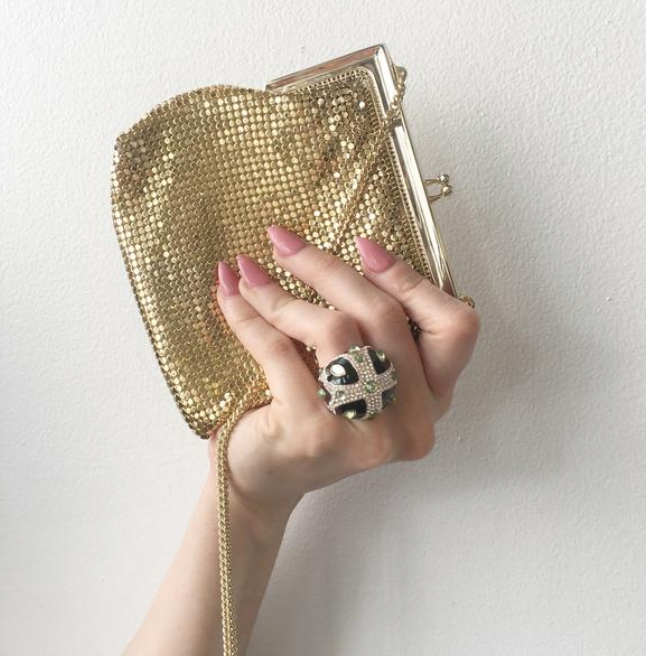
Fashion Flashback: Handbags
Fashion Flashback: Handbags by Morgan Watkins
Traditionally, accessories have been thought of as tools to spruce up an otherwise simple or lacking outfit. Rings, bracelets, necklaces and more are seen as strictly ornamental in most modern day cultures. But one accessory that breaks that mold is the handbag. Convenient and cute, handbags stand alone in the world of accessorizing as practical and handy safety blankets for individuals worldwide. According to National Geographic, the oldest handbag known to man dates back all the way to 2500 to 2200 B.C. Discovered in Germany, the ancient purse was found containing a flap adorned with over 100 dog teeth.

(Image from https://news.nationalgeographic.com/news/2012/06/120627-worlds-oldest-purse-dog-te eth-science-handbag-friederich/)
Even more interesting, handbags were initially carried by both men and women in early times. Before pockets were introduced in the 17th century, bags were most commonly worn for their practicality. The first widely worn form of purses were actually worn in pairs around the hip and under the voluminous layers of fabric within a woman’s skirt; these were called thigh pockets. But once the modern pocket was invented, purses fell out of favor for men. bit of controversy over the donning of purses: since they were worn underneath dresses and skirts, they were categorized as underwear. But eventually, it became less scandalous to carry a purse as styles were reinvented over time. Bags were originally linked onto chains by hook, which were called chatelaines. Chatelaines could carry a variety of trinkets and everyday necessities, like keys, scissors and sewing materials. Since they were typically made of precious metals, chatelaines were considered jewelry as well as a symbol of wealth and status.
In the late 17th and early 18th centuries, the reticule handbag was in. The reticule, also known as the indispensable, was a drawstring bag that was quite small in size, only able to carry a bit of makeup, playing cards and money. Embroidery was also a fan favorite within the realm of handbags, depicting portraits and intricate floral designs.
By the mid-1800s, bags increased in size and the designer handbag was born. An entrepreneur by the name of Samuel Parkinson decided that his wife’s purse was far too small and a bit flimsy, so he decided to order her a custom set of handmade leather luggage in various sizes and shapes to accommodate her travels as well as her everyday living. The set was designed by H.J. Cave & Sons, and being that the pieces were of such high quality and craftsmanship, the bags made it clear that Mrs. Parkinson was high society. Interestingly enough, it was said that designer H. J. Cave inspired prominent fashion legends we know and love today, like Louis Vuitton and Guccio Gucci.

(Image from https://www.pinterest.com.au/pin/85990674110055021/)
It was around the end of the 19th century and the beginning of the 20th that larger bags caught on with the general public. Practicality was once again brought into play when designing purses, which were not only larger in size but higher in quality. Handles were sturdier, zippers and other closures better constructed, and new materials and shapes were introduced. The clutch, for example, popped up in the 1930s in the form of the minaudière, which was a small box crafted from rich metals like silver and gold.
During this time, bags simultaneously became more extravagant, ornamental and defined by the designer on the label. In 1935, we saw the birth of the Hermès Kelly bag, which actress Grace Kelly used to disguise her growing baby bump from the paparazzi.

(Image from https://www.yahoo.com/lifestyle/the-birkin-bag-a-better-investment-than-gold-11551676 9.html)
As the cosmetics industry grew after World War II, women needed larger bags to hold all of their blushers and mascaras, which is why the mid-sized envelope bag was a popular clutch carried by women in America. Roomy shoulder bags took over during the 50s while flashy metallic purses were adored by women in the disco days. The 80s were all about excess, as expensive and over the top designer bags were all the rage. Chanel, Gucci, Coach and Louis Vuitton were heavy hitters in the handbag game, but it was during the 1980s that the iconic Birkin bag by Hermes stole the hearts of fashion lovers the world over. The 90s was a big year for Dior, as the Dior Saddlebag rose to fame, along with the Lady Dior bag, made famous by the charming and widely loved Princess Diana.
The 2000s saw classic designer bags being reborn and revamped. The famous quilted Chanel 2.55, originally created by the one and only CoCo Chanel, was given a modest facelift by Karl Lagerfeld in 2005. Louis Vuitton also debuted a whimsical spin on their classic logo in collaboration with Japanese artist Takashi Murakami.

(Image from https://www.highsnobiety.com/2015/07/17/louis-vuitton-murakami-pieces/)
Today, the possibilities for handbags are endless. From bucket bags and massive crossbodies to totes and miniature clutches, purses can be trendy, practical or just fiercely fabulous. Looking for a banging bag, or want to rehome an old treasure? Head to talkingfashion.net to check out some stunning handbags or consign one of your own!
References:
Borrelli-Persson, Laird BORRELLI-PERSSON. “Vogue.com’s It Bag Hall of Fame: A History of the Most Coveted Accessories.” Vogue, 15 Jan. 2015, https://www.vogue.com/article/best-it-bags-history.
Curry, Andrew. “World’s Oldest Purse Found—Studded With a Hundred Dog Teeth?” National Geographic, 27 June 2012, https://news.nationalgeographic.com/news/2012/06/120627-worlds-oldest-pursedog-teeth-science-handbag-friederich/.
“The History of Handbags — a 5-Minute Guide.” 5 Minute History, http://fiveminutehistory.com/the-history-of-handbags-a-5-minute-guide/.
“THE HISTORY OF BAGS AND PURSES.” Tassen Museum, https://tassenmuseum.nl/en/knowledge-centre/history-of-bags-and-purses/.
“The History of Handbags — a 5-Minute Guide.” 5 Minute History, http://fiveminutehistory.com/the-history-of-handbags-a-5-minute-guide/




